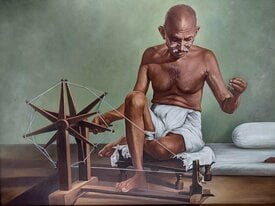A speech is a spoken discourse or an expression of thoughts delivered in front of an audience by the speaker. In this post, we have written a brilliant ‘Short Speech on Mahatma Gandhi’.
A speech can perform one or more of the following functions:
Daily Test - Attempt Now
- To convince the audience
- To provoke the audience to take an action
- To inspire the audience
- To inform the audience

Short Speech on Mahatma Gandhi
Respected Principal, teachers, and dear friends,
Today I am going to speak about Mahatma Gandhi.
Mahatma Gandhi was born at Porbandar in the Kathiawar district of Gujarat in 1869. He went to England to study Law in 1888. Mahatma Gandhi practized law in South Africa, from 1893 to 1914. In South Africa, he saw racial discrimination and soon turned into the leader of a struggle against racist authorities in the country. He shaped the Natal Indian Congress to fight against the racist policies of the South African government. It was here that the unique strategy of Satyagraha developed.
Satyagraha of Mahatma Gandhi was based on truth and peacefulness. Mahatma Gandhi got back to India in January 1915 and made a broad visit through the country in the following three years. In 1917 and 1918, he was engaged in three critical struggles in Champaran (Bihar), Ahmedabad and Kheda in Gujarat.
At Champaran in Bihar, the workers were bound by law to grow indigo on 3/20 parts of their land. They were forced to sell indigo at fixed rates which were very low to European planters. The indigo cultivators welcomed Mahatma Gandhi to investigate their tragedies and take up their goal. The district administration prohibited his entrance into the district. Mahatma Gandhi offered Satyagraha because of which an enquiry was requested into the agonies of indigo cultivators.
In Ahmedabad, Mahatma Gandhi gave leadership to the mill workers in a strike against mill owners who would not pay higher wages to the workers. He went on a hunger strike. Finally, the mill owner had to bow down and consented to give a 35% hike in salaries to the workers.
In 1918, the harvests failed in Kheda, and the ranchers were not in that frame of mind to pay land revenues to the government. They requested the government to waive their revenues, however, their supplications went unheard. Mahatma Gandhi took up the reason for the Kheda farmers and offered Satyagraha. At long last, the government had to investigate their requests and arrived at a settlement with the farmers.
Mahatma Gandhi made the Indian National Movement a mass development. He gave leadership to the majority who followed him irrespective of their caste, class or religious contrasts.
Congress launched the Non-Cooperation Movement but Mahatma Gandhi suspended the movement because of the incident which happened at Chauri Chaura in Uttar Pradesh. A parade of around 3000 people marched to the Chauri Chaura police station. After being fired upon, the crowd turned violent and set the police station on fire killing 22 cops. This incident stunned Gandhi as he wanted to gain freedom by following the strategies of non-violence.
In 1931, Mahatma Gandhi launched the Civil Disobedience Movement. Simon Commission was the main factor which led to the starting of the Civil Disobedience Movement.
The Civil Disobedience Movement began with Mahatma Gandhi with the Dandi March. He started the march from Sabarmati Ashram to Dandi, a small village situated on the sea coast of Gujarat. The violation of the Salt Law at Dandi denoted the start of the Civil Disobedience Movement.
The government started negotiations with Mahatma Gandhi who was in jail to stop the Civil Disobedience Movement. This brought about the signing of a pact between Lord Irwin, the Viceroy of India, and Gandhi which came to be known as the ‘Gandhi Irwin Pact’.
Gandhi believed that non-violence is a positive and dynamic power. Mahatma Gandhi trusted that the utilization of swadeshi products would make India independent and confident. He focused on the use of the charkha and khadi.
Although the movement did not bring freedom to the country, it played an important role in extending the freedom struggle of the people. On 30 January 1948, Mahatma Gandhi was assassinated by Nathuram Vinayak Godse while walking to his prayer meeting on the lawn of the Birla House compound in Delhi.
With this, I conclude my speech. Thank you all for your patience and cooperation.
FAQ (Frequently asked questions)
Where was Gandhiji born?
Mahatma Gandhi was born at Porbandar in the Kathiawar district of Gujarat in 1869.
Where did Mahatma Gandhi practice law?
Mahatma Gandhi practized law in South Africa, from 1893 to 1914.
What is the concept of Satyagraha?
Satyagraha of Mahatma Gandhi was based on truth and peacefulness. Mahatma Gandhi’s principle of non-violence was set down on the rule that no injury ought to be caused either by words or by activity. Gandhi believed that peacefulness is a positive and dynamic power.
When did Gandhi die and how?
On 30 January 1948, Mahatma Gandhi was assassinated by Nathuram Vinayak Godse while walking to his prayer meeting on the lawn of the Birla House compound in Delhi.
Also, Read

Speech on Janmashtami

Speech on Diwali
